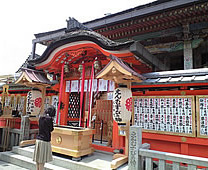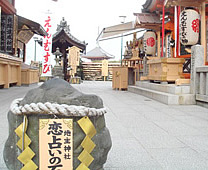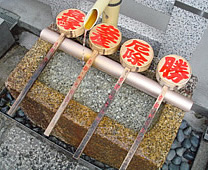
Travel Guide
Jishujinja Temple is one of the most famed and popular match-making temples in Kyoto. Visited by young girls and couples who are looking for romance or marriage, the temple is dedicated mainly to Okuninushi, a Japanese “god of love” and many other gods such as Sasunoo-no-mikoto and Shidahime-no-mikoto who are the parents of Okuninushi. People come to play not only for success in finding the right partner but also for avoidance of bad luck, and accomplishment of school work, etc. It is said that Emperor Saga returned to the temple to see Jishu-zakura for 3 times because of its beauty on his way home in 811. Jishu-zakura makes the temple the viewing spot in Kyoto.
Jishujinja Temple is famous for match-making but the temple was originally founded to guard the gods of Kiyomizudera Temple. Jishujinja Temple became independent from Kiyomizudera Temple in the early of Meiji era. Jishujinja Temple has long history which could be back to the period Japanese Mythology. The area around the temple is called Horai-san Mountain which is believed to be the spiritual mountain of longevity.
This shrine was built by the third Shogun Tokugawa Iemitsu in 1633. In this building the structures of Irimoya-zukuri and Gongen-zukuri are combined with colorfully painted Japanese cypress bark, and they are designated as national important cultural assets and world cultural properties. Dragon painting on the ceiling of the Haiden is painted by Motonobu Kano. Visitors feel like been staring by the dragon from every point of viewing the dragon, therefore, the dragon is named Happonirami-no-ryu (the dragon staring at all sides). It is said in the legend that the dragon flies to drink the water of Otowa Falls in Kiyomizudera Temple every night.
Okage Myojin is one of the gods dedicated in the Jishujinja Temple. It is said one wish can be granted by praying to Okage Myojin. Behind the Okage Myojin, there is a Japanese cedar called Inori-no-sugi. In the Edo period, many women did ushi no toki mairi (ox-hour (between 1 and 3am)) shrine-visit to lay a curse upon a target that is traditional to Japan) on the Japanese cedar so there are many punching hole on it.
The primary love lure of the shrine are two rocks. The rocks are said could date back to Jomon period (12,000 BC - 300 BC). They stand about 6 meters (20 feet) apart, and according to legend, if one walks between the two stones with their eyes closed, then they are assured luck in love. However, should someone help along the way, one will only find love through the interloping of another. The challenge is a popular one, with the love-sick attempting to thread their way through the throngs with eyes shut and arms outstretched. The challenge has long history since the challenge is drawn in the painting Kiyomizudera Sanpai Mandara which was painted in the Muromachi period.
 |
 |
 |
| Main Hall | Love fortune-telling rock and Haiden | Chozuya |
Travel Advice
|
|||
Visit
| Address | 1-317, Kiyomizu, Higashiyama-ku, Kyoto-shi, Kyoto | |
| Phone | 075-541-2097 | |
| Admission | Free | |
| Hours | 09:00 to 17:00 | |
| Closed | Open 7 Days a Week | |
| Duration | 15 minutes | |
| Getting There | By Train 12 minutes ride by City Bus No.100 or 206 from JR Kyoto Station to the Gojozaka bus stop, then walk approximately 15 minutes. Take City Bus No.207 from Kawaramachi Station on Hankyu Railway Kyoto Honsen or Gion-shijo Staion on Keihan Electric Railway Keihan Honsen to Gojozaka bus stop, then walk approximately 12 minute. 15 minutes ride by car from JR Kyoto Station. By Car Take Meishin Expressway to the Kyoto-higashi or Kyoto-minami exit. It is approximately 30 minutes from exit. |
|
| Parking | No parking available | |

